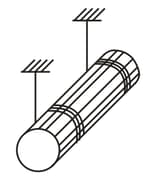The ends of thin threads, tightly wound on the axle of radius , of the Maxwell disc, are attached to a horizontal bar. When the disc unwinds, the bar is raised to keep the disc at the same height. The mass of the disc with the axle is equal to , and the moment of inertia of the arrangement, relative to its axis, is . Find the tension of each thread and the acceleration of the bar.

Important Questions on PHYSICAL FUNDAMENTALS OF MECHANICS
A thin horizontal uniform rod , of mass , and length , can rotate freely about a vertical axis passing through its end . At a certain moment, the end , starts experiencing a constant force , which is always perpendicular to the original position of the stationary rod and directed in a horizontal plane. Find the angular velocity of the rod as a function of its rotation angle , counted relative to the initial position.
In the arrangement shown in the figure, the mass of the uniform solid cylinder, of radius , is equal to , and the masses of two bodies are equal to and . The thread slipping and the friction in the axle of the cylinder are supposed to be absent. Find the angular acceleration of the cylinder and the ratio of tensions, , of the vertical sections of the thread in the process of motion.
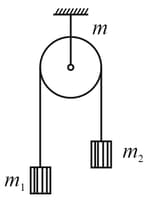
In the system shown in the figure, the masses of the bodies are known to be and , the coefficient of friction between the body and the horizontal plane is equal to , and a pulley of mass , is assumed to be a uniform disc. The thread does not slip over the pulley. At the moment , the body , starts descending. Assuming the mass of the thread and the friction in the axle of the pulley to be negligible, find the work performed by the friction forces acting on the body , over the first seconds, after the beginning of the motion.
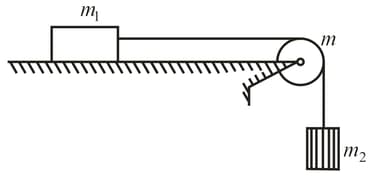
A uniform cylinder of radius is spinned about its axis to the angular velocity and then placed in a corner. The coefficient of friction between the corner walls and the cylinder is equal to . How many turns will the cylinder accomplish before it stops?
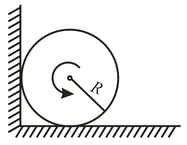
A uniform cylinder, of radius and mass , can rotate freely about a stationary horizontal axis . A thin cord, of length and mass , is wound on the cylinder in a single layer. Find the angular acceleration of the cylinder as a function of the length of the hanging part of the cord. The wound part of the cord is supposed to have its centre of gravity on the cylinder axis.
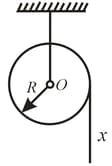
A uniform cylinder of mass , and radius , starts descending, at a moment , due to gravity. Neglecting the mass of the thread, find:
the tension of each thread and the angular acceleration of the cylinder;
the time dependence of the instantaneous power developed by the gravitational force.
